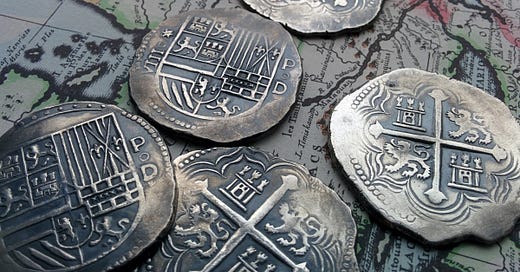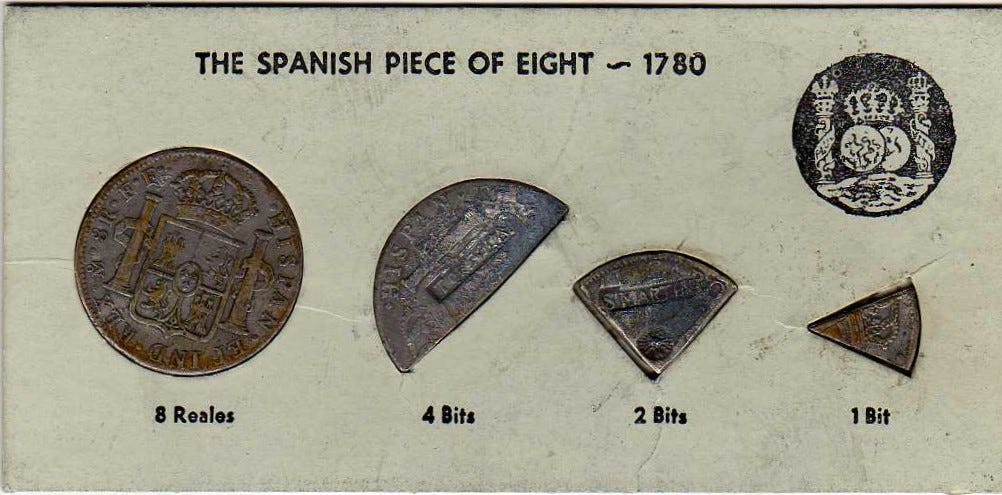How Was The "Pieces of Eight" Coin Cut into Bits?
Have you ever wondered why the Spanish silver dollar was called pieces of eight?
The Spanish colonial empire controlled the massive Potosí silver mine in Bolivia, which produced most of the silver in the world. Here, the Spanish minted a silver dollar, which became known as "pieces of eight" in the English-speaking world. The name came from the fact that one Spanish silver dollar (Peso) was worth eight reals.
It is easy to think about the silver dollar as the base unit. However, it was the Spanish real which was the currency and which got simply minted in ½, 1, 2, 4 and 8-real denominations. It is simply the 8-real, which got so widely used around the world that it became the currency people talk about and why you see it pop up in pirate movies.
For anyone interested in number systems, the dominations are interesting to observe. Money was not ten-based because that was impractical to work with. If you got a pizza, you don't cut it into 10 pieces. That is really hard to do. You cut it into 2, 4 or 8 pieces. If somebody was selling say eggs, grain, or anything else, they would give some price for say eight eggs or a loaf of bread. What if you could not afford the whole bread or didn't need whole bread? Maybe you just want half or a quarter. That is easy to cut, and it helps that your money can be divided in similar fashion. Nobody is going to ask for 1/5 of a loaf of bread.
The extra benefit is that it allowed people to literally cut coins into pieces. People would indeed cut Spanish silver dollars into halves, quarters, or bits. A bit is what the English would call a real. Hence, a silver dollar was made up of 8 bits and 2 bits thus corresponded to a quarter of a dollar (2/8 is 1/4).
I want to clarify one confusion I had when reading up on this topic: The Spanish did not make the coin in a special way that made it easier to cut it into eight pieces. It is just that with tools it is easier to measure up and cut something in half repeatedly than say cutting a coin into 10 identical pieces. Again, think of how you can cut a pizza into eight equal pieces fairly easily by hand.
Thus, if people did not have a 2-real denominated coin, they could simply cut an 8-real coin in half and then cut one of the halves in half again to get something with the same value as a 2-real coin. This worked because the coins derived their value from the silver inside them, and not because of any authenticity of the minter.
It is worth remembering why coins came about in the first place. Before coins, one would pay with lumps of silver or gold that got weighed. That is obviously impractical as you need a weighing device each time you need to pay or receive payment. The solution was to make lumps of gold and silver into standardized sizes which people could easily recognize and use. That is essentially what a silver coin is. It is a lump of silver in standardized size, so people can easily recognize the value without weighing it.
The reason the coins have pictures and ornamentation on them is, so you get a sort of proof from the government that they actually minted the coins; otherwise you could not trust the content of the coin.
Coins did not get used like in fantasy games where you got copper coins, silver coins and gold coins. Silver was the standard, as you could then easily figure out fractional values. Using different metals which could prices which fluctuate relative to each other would be impractical. But how did poor people pay for stuff? How did you pay for small things? Wasn't a silver coin worth a lot?
Indeed, silver coins were worth a lot, but people did not use money back in the day like we do today. Money was not involved in every little transaction. In fact, most trade did not involve money it all. So, it was barter-based? Nope, no society really used barter historically. That is a bit of a myth. Most trade has ever since humans began trading has been based on debt.
If I sell you a bottle of wine, I can record how much you owe me in bits, dollars or whatever unit is most practical. We all know putting expenses on a tab, right? You frequent a place, so they keep a tab which you pay, say weekly or monthly. That is basically how trade worked historically. People kept track of how much they owed each other. After, nobody lived in modern metropolises with millions of people. Most people lived in relatively small towns where everybody knew each other.
So, who needed coins? Merchants and armies required coins. They traveled to far away places where you did not necessarily know or trust the person you made deals with. Merchants would naturally buy larger quantities of goods for which valuable coins were better suited than the smaller trade common folk engaged in.





